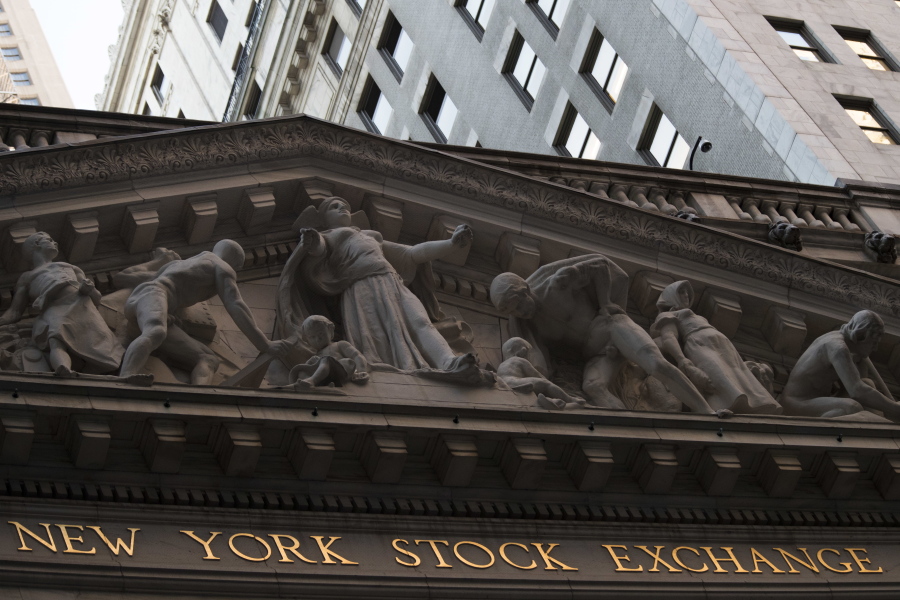NEW YORK — Stocks retreated on Wednesday and gave back some of their gains from a day earlier, when the Standard & Poor’s 500 index had one of its best days of the year.
Advertising companies and retailers had some of the steepest drops on worries about their earnings, while prices for Treasury bonds and gold rose modestly as investors sought safer ground. It’s the latest move lower for a stock market that’s yo-yoed since setting a record high earlier this month.
The Standard & Poor’s 500 index fell 8.47 points, or 0.3 percent, to 2,444.04, relinquishing about a third of its big gain from Tuesday. The loss snapped a two-day winning streak that followed a nearly two-weeklong slump. After all its back and forth, the S&P 500 is still within 1.5 percent of its record.
The Dow Jones industrial average fell 87.80 points, or 0.4 percent, to 21,812.09, and the Nasdaq composite lost 19.07, or 0.3 percent, to 6,278.41. The Russell 2000 index of small-cap stocks fell 1.80, or 0.1 percent, to 1,369.74.
Advertising companies had the biggest losses in the S&P 500 after an industry giant cut its forecast for revenue this year. WPP warned that its clients are feeling pressure to control their spending, and its shares plunged 10.9 percent in London. In the U.S., Omnicom Group fell $5.47, or 7 percent to $72.66, and Interpublic Group lost $1.32, or 6.3 percent, to $19.58.
Lowe’s, the home-improvement retailer, also dragged down the S&P 500 after it reported profit and revenue for the latest quarter that were weaker than analysts expected. It gave a profit outlook for the year that fell short of Wall Street’s forecast, and its stock fell $2.81, or 3.7 percent, to $73.01. A report showing that sales of new homes were weaker in July than economists expected didn’t help.
Worries about politics were a big reason for the market’s stumbles in recent weeks. In Washington, the concern is about whether the government can push through tax cuts and other pro-business policies that were considered slam dunks early this year. Now, the market seems to have little to no expectation for much help coming from Washington, said Katie Nixon, chief investment officer at Northern Trust Wealth Management.
“Actions speak louder than words, and when we see actual action, you’ll see markets sit up and take notice,” she said. “But so far it’s been a rhetorical exercise.”
She said she noticed CEOs talking a lot about their hopes for tax reform or infrastructure spending earlier this year, when companies were reporting their results for the January-through-March quarter. But in conference calls the last few weeks, as CEOs reported their results for the spring quarter, Nixon heard much less of such talk.
The government is coming close to some crucial deadlines, including one to increase its borrowing authority in order to avoid a default on its debt and another to prevent a government shutdown.
In a speech late Tuesday, President Donald Trump said that “if we have to close down our government, we’re building that wall” that he wants on the border between Mexico and the United States. He also said that he thinks the U.S. government will “end up probably terminating” the North American Free Trade Agreement with Canada and Mexico, though he also said that he has yet to make up his mind.
Besides Washington, markets are also looking toward the mountains of Wyoming, where central bankers from around the world are gathering soon.
The heads of the Federal Reserve and the European Central Bank are expected to speak at a symposium, which begins Thursday, and investors are waiting to hear if any change is upcoming in their support for the global economy.
Most analysts expect to hear nothing surprising from the meeting. The Fed has already begun raising interest rates and is preparing to pare back the $4.5 trillion in Treasurys and other investments it’s amassed.
Prices for Treasurys rose, which in turn pushed down yields. The 10-year Treasury yield fell to 2.16 percent from 2.21 percent late Tuesday. The two-year yield dipped to 1.31 percent from 1.33 percent, and the 30-year yield dropped to 2.75 percent from 2.79 percent.
In overseas stock markets, the French CAC 40 fell 0.3 percent, Germany’s DAX dropped 0.5 percent and the FTSE 100 in London was close to flat. Japan’s Nikkei 225 rose 0.3 percent, while South Korea’s Kospi was virtually flat.
The dollar fell to 109.01 Japanese yen from 109.52 yen late Tuesday. The euro rose to $1.1821 from $1.1752, and the British pound fell to $1.2804 from $1.2828.
Benchmark U.S. crude oil rose 58 cents to settle at $48.41 per barrel. Brent crude, the international standard, rose 70 cents to $52.57 per barrel.
Gold rose $3.70 to settle at $1,294.70 per ounce, silver gained 6 cents to $17.05 per ounce and copper slipped a penny to $2.98 per pound.
Natural gas fell 1 cent to $2.93 per 1,000 cubic feet, heating oil rose 3 cents to $1.62 per gallon and wholesale gasoline gained 3 cents to $1.62 per gallon.



